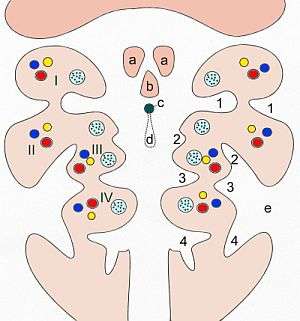Pharyngeal groove
A pharyngeal groove (or branchial groove, or pharyngeal cleft[1]) is made up of ectoderm unlike its counterpart the pharyngeal pouch on the endodermal side.
| Pharyngeal groove | |
|---|---|
 Pattern of the branchial arches. I-IV branchial arches, 1-4 pharyngeal pouches (inside) and/or pharyngeal grooves (outside) a Tuberculum laterale b Tuberculum impar c Foramen cecum d Ductus thyreoglossus e Sinus cervicalis | |
| Details | |
| Precursor | Ectoderm |
| Identifiers | |
| Latin | sulcus pharyngei |
| TE | E5.4.2.0.0.0.3 |
| Anatomical terminology | |
The first pharyngeal groove produces the external auditory meatus (ear canal).[2] The rest (2, 3, and 4) are overlapped by the growing 2nd pharyngeal arch, and form the floor of the depression termed the cervical sinus, which opens ventrally, and is finally obliterated.
See also
References
- "musom.marshall.edu". Retrieved 2009-05-28.
- "Archived copy". Archived from the original on 2008-12-17. Retrieved 2008-02-14.CS1 maint: archived copy as title (link)
This article is issued from
Wikipedia.
The text is licensed under Creative
Commons - Attribution - Sharealike.
Additional terms may apply for the media files.